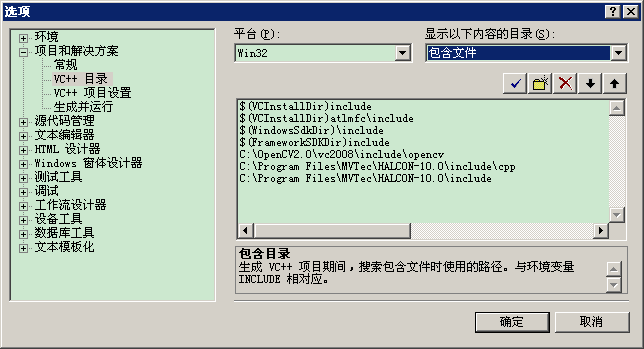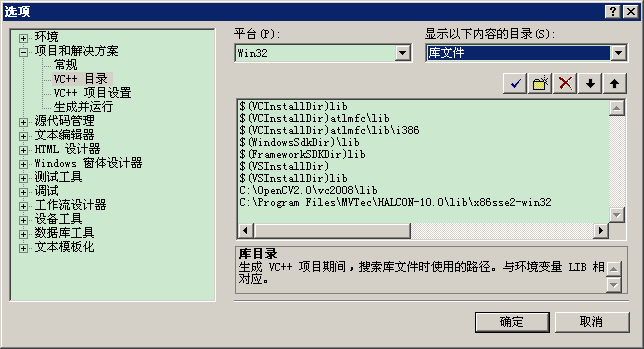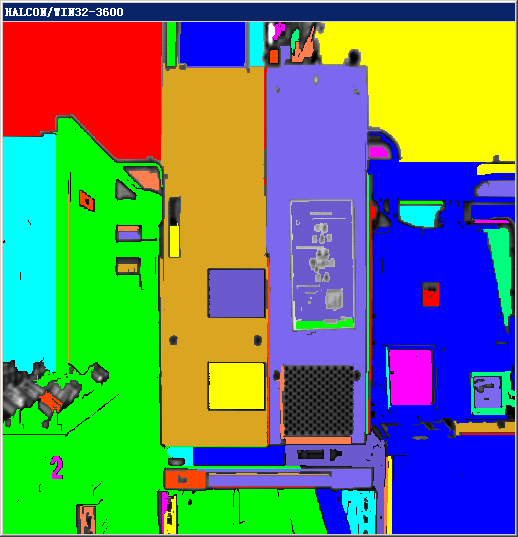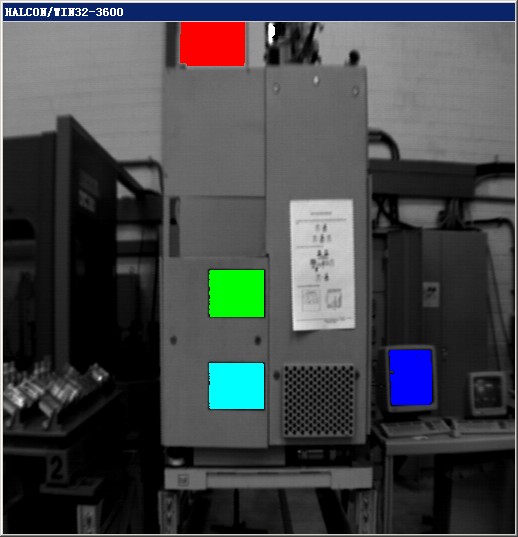在使用C++编写halcon之前,确定自己有较好的C++基础,并熟悉一套开发平台如VC
Programmers_guide.pdf chapter7中有关于creating Aplicatin with halcon/c++的详细介绍
以vs2008为例 工具---》选项 (有图介绍不配文字啦)


用C++写例子 ~~取狒狒的眼睛
//
#include "stdafx.h"
#include "HalconCpp.h"
#pragma comment(lib,"halconcpp.lib")
int main()
{
using namespace Halcon;
HImage Mandrill("monkey");
HWindow w;
w.Display(Mandrill);
w.Click();
HRegion Bright = (Mandrill >=128); // 取亮度大于128的区域
HRegionArray conn = Bright.Connection();
//取面积在500~9000的区域,狒狒的大鼻子也是大于128的,显然不是我们检测的重点根据面积舍去它
HRegionArray large = conn.SelectShape("area","and",500,9000);
//眼睛是椭圆形的anisometry 是离心率即ra/rb 两半径之比,目测来看取1.2 -1.7
HRegionArray eyes = large.SelectShape("anisometry","and",1.2,1.7);
eyes.Display(w);
w.Click();
return 0;
}
#include "stdafx.h"
#include "HalconCpp.h"
#include <iostream>
#pragma comment(lib,"halconcpp.lib")
using namespace std;
using namespace Halcon;
int main()
{
HImage image("alpha1");
HRegion region;
HWindow w;
long threshold;
image.Display(w);
w.Click();
// image.GetDomain -- 获得图像region
//sigma --- 高斯平滑系数
//Percent --- 前景背景灰度不同百分比 95 代表 至多有5%是最大灰度值
region = image.CharThreshold(image.GetDomain(),2,95,&threshold);
image.Display(w);
region.Display(w);
w.Click();
cout<<"Threshold for 'alpha': "<<threshold;
w.Click();
return 0;
}
注意:参考手册中的操作符不全,A complete list can be found in the file include\cpp\HCPPGlobal.h.
1.关于参数:
①.halcon的输入参数 (input parameters)不会被操作符改变,也就是说是按值传递的
如下代码示例
HImage original_image("monkey"), smoothed_image;
smoothed_image = original_image.MeanImage(11, 11);
meanimage不会改变original_image,而中值后的图像保存在返回值 smoothed_image中
②.与之相反的是输出参数(output parameters),所以传的是指针或者引用
2.halcon /C++关于面向对象和过程
这是通过类来调用方法的 ,面向对象方式
HImage image("barcode/ean13/ean1301");
HTuple paramName, paramValue;
HBarCode barcode(paramName, paramValue);
HRegionArray code_region;
HTuple result;
code_region = barcode.FindBarCode(image, "EAN-13", &result);
code_region = image.FindBarCode(barcode, "EAN-13", &result);
面向过程的方式
Hobject image;
HTuple barcode;
Hobject code_region;
HTuple result;
read_image(&image, "barcode/ean13/ean1301");
create_bar_code_model(HTuple(), HTuple(), &barcode);
find_bar_code(image, &code_region, barcode, "EAN-13", &result);
3.halcon/c++所有的 对象 可以在C:\Program Files\MVTec\HALCON-10.0\include\cpp 中找到 (以halcon安装在C盘为例)
4.halcon/c++的数组模式
我们可以用操作符来 打开多个图片 region 等等 看该操作是否支持 数组模式 要看它的定义了
如图所示
数组的几点说明:
① 创建,初始化数组
C++ 可以通过 []
C 通过 gen_empty_obj 增加数组 concat_obj
②操纵对象
C++ 通过[N] ,统计数组元素个数 num()
C select_obj count_obj
③iconic 数组以 0 开始 , Hobject 数组 以 1 开始
④通过例子说明第四点
#include "stdafx.h"
#include "HalconCpp.h"
#include <iostream>
#pragma comment(lib,"halconcpp.lib")
using namespace std;
using namespace Halcon;
//~~ 提取字符
int main()
{
HImageArray images;
HRegionArray regions;
HTuple thresholds;
HWindow w;
for (int i = 1; i <=2;++i)
{
//HTuple("alpha") +i 的解释
//HTuple 中有对 operater + 的重载
//HTuple("alpha") +i ~~~ alpha1 alpha2.....
images[i-1] = HImage::ReadImage(HTuple("alpha") +i);
}
//这一句相当于对 images中所有的对象进行了 charthreshold操作
regions = images.CharThreshold(images[0].GetDomain(),2,95,&thresholds);
for (int i = 0 ; i<regions.Num();++i)
{
images[i].Display(w);
w.Click();
regions[i].Display(w);
w.Click();
cout<<"threshold : "<<thresholds[i].L()<<endl;
}
w.Click();
return 0;
}
5. 关于参数转换
• Converting Hobject into iconic parameter classes
Hobject p_image;
read_image(&p_image, "barcode/ean13/ean1301");
HImage o_image(p_image);
Iconic parameters can be converted from Hobject to, e.g., HImage simply by calling the construc-
tor with the procedural variable as a parameter.
• Converting handles into handle classes
HTuple p_barcode;
create_bar_code_model(HTuple(), HTuple(), &p_barcode);
HBarCode o_barcode;
o_barcode.SetHandle(p_barcode[0]);
o_code_region = o_barcode.FindBarCode(o_image, "EAN-13", &result);
Handles cannot be converted directly via a constructor; instead, you call the method SetHandle()
with the procedural handle as a parameter.
• Converting handle classes into handles
p_barcode = o_barcode.GetHandle();
Similarly, a handle can be extracted from the corresponding class via the method GetHandle().
You can even omit the method, as the handle classes provide cast operators which convert them
automatically into handles.
p_barcode = o_barcode;
•Converting iconic parameter classes into Hobject
Hobject p_code_region = o_code_region.Id();
Iconic parameters can be converted from classes like HRegion back into Hobject via the method
Id(). In contrast to the handle classes no cast operator is provided.
• Converting HWindow into a window handle
long p_window;
open_window(0, 0, width/2, height/2, 0, "visible", "", &p_window);
HWindow o_window(0, 0, 100, 100, 0, "visible", "");
p_window = o_window.WindowHandle();
disp_obj(p_code_region, p_window);
In contrast to other handles, procedural window handles cannot be converted into instances of the
class HWindow! However, you can extract the handle from an instance of HWindow via the method
WindowHandle().
6 . The halcon Parameter classes
6.1 Iconic Objects
基类为Hobject
HImage ,HRegion,HXLD 基类为Hobject
6.1.1 Reions
region 是图像平面的一组坐标点 , 它可能不是连接的,可能含有洞,它可以比图像还大。
通过一个例子来了解HRegion
#include "stdafx.h"
#include "HalconCpp.h"
#include <iostream>
#pragma comment(lib,"halconcpp.lib")
using namespace std;
using namespace Halcon;
/*
例子介绍了region的用法 ,更详细的介绍在 progarma_guide chapter6.1.1
*/
int main()
{
HImage image("mreut");
HRegion region;
HWindow w;
region = image >=190;
w.SetColor("red");
region.Display(w);
w.Click();
//region.Fillup() 调用方法
HRegion filled = region.FillUp();
filled.Display(w);
w.Click();
//运算符重载 开运算 >> 腐蚀 <<膨胀 , 半径4.5
HRegion open = (filled >>4.5)<<4.5;
w.SetColor("green");
open.Display(w);
w.Click();
w.ClearWindow();
//平移
HDPoint2D trans(-100 , -150);
HRegion moved = open + trans;
HRegion zoomed = moved * 2.0;
zoomed.Display(w);
w.Click();
return 0;
}


#include "stdafx.h"
#include "HalconCpp.h"
#include <iostream>
#pragma comment(lib,"halconcpp.lib")
using namespace std;
using namespace Halcon;
/*
例子介绍了regionArry的用法
*/
int main()
{
HImage image("fabrik");
// 1 1 row col 越小越精细
// 4 容差 种子和被检测像素值差
// 100 最小region size
HRegionArray regs = image.Regiongrowing(1,1,4,100);
HWindow w;
w.SetColored(12);
image.Display(w);
w.Click();
regs.Display(w);
w.Click();
HRegionArray rect;
for (int i = 0 ; i < regs.Num() ; ++ i )
{
// compactness ~~ 在图像处理中经常叫做圆形度 而这里用作 region的紧密度
//C = L^2 / (4 F pi)) L = 周长 F = 面积
//C = 1 是 为圆 ,region 较长是 或者region 有洞洞时 C >1
//这里就是得出了 比较方正的 没小洞洞的 region
if ( (regs[i].Area() > 1000) && ( regs[i].Compactness() < 1.5) )
rect.Append(regs[i]); //RegionArry 添加元素哦
}
image.Display(w);
rect.Display(w);
w.Click();
return 0;
}
6.1.2 Images
#include "stdafx.h"
#include "HalconCpp.h"
#include <iostream>
#pragma comment(lib,"halconcpp.lib")
using namespace std;
using namespace Halcon;
/*
drawregion 画感兴趣区域
meanimage 做个中值滤波
和中值滤波前图像比较
*/
int main()
{
HImage image("mreut");
HWindow w;
image.Display(w);
cout<< " width = " << image.Width()<<endl;
cout << " height = " << image.Height() <<endl;
HRegion mask= w.DrawRegion();
// & 重载 取感兴趣区域的图像
HImage reduced = image & mask;
w.ClearWindow();
reduced.Display(w);
w.Click() ;
HImage mean = reduced.MeanImage(61,61);
mean.Display(w);
HRegion reg = reduced.DynThreshold(mean,3,"light");
reg.Display(w);
w.Click();
return 0;
}
6.1.2.2 像素值
操纵像素的两种方法
int main()
{
HByteImage in("mreut");
HByteImage out = in ;
HWindow w;
in.Display(w);
w.Click() ;
int nwidht = in.Width();
int nheight = in.Height();
long end = nwidht * nheight;
for (int k = 0 ; k < end ; k++)
{
//方法1
//int pix = in.GetPixVal(k);
//out.SetPixVal(k,255 - pix);
//方法2
out[k]= 255 - in[k];
}
out.Display(w);
w.Click();
return 0;
}
6.1.3 XLD Objects
XLD is the abbreviation for eXtended Line Description. This is a data structure used for describing areas
(e.g., arbitrarily sized regions or polygons) or any closed or open contour, i.e., also lines. In contrast to
regions, which represent all areas at pixel precision, XLD objects provide subpixel precision. There are
two basic XLD structures: contours and polygons.
Similarly to images, HALCON/C++ provides both a base class HXLD and a set of specialized classes
derived from HXLD, e.g., HXLDCont for contours or HXLDPoly for polygons. For all classes there exists
a corresponding container class, e.g., HXLDArray.
In contrast to the classes described in the previous sections, the XLD classes provide only member
functions corresponding to HALCON operators (see also section 5.2.2 on page 35).
6.1.4 Low - level iconic objects 底层iconic 对象
the class Hobject is used for all iconic parameters, be it an image, a region, or even an image array
In fact, the class Hobject is HALCON’s basic class for accessing the internal data management
Furthermore, Hobject serves as the basis for the class HObject and the derived classes, e.g., HImage.
As noted above, an instance of Hobject can also contain a tuple (array) of iconic objects. Unfortunately,
Hobject provides no special member functions to add objects or select them; instead, you must use the
operators gen_empty_obj, concat_obj, select_obj, and count_obj 。
一个Hobject实例可以包含一组iconic 对象,但Hobject 没有提供增加或选择它们的成员函数,所以必须通过
gen_empty_obj, concat_obj, select_obj, and count_obj 来解决。
6.2 Control parameters
附件列表
- 从0开始搭建SQL Server AlwaysOn 第一篇(配置域控)
从0开始搭建SQL Server AlwaysOn 第一篇(配置域控) 第一篇http://www.cnblogs.com/lyhabc/p/4678330.html第二篇http://www.cnb ...
- Python爬虫小白入门(四)PhatomJS+Selenium第一篇
一.前言 在上一篇博文中,我们的爬虫面临着一个问题,在爬取Unsplash网站的时候,由于网站是下拉刷新,并没有分页.所以不能够通过页码获取页面的url来分别发送网络请求.我也尝试了其他方式,比如下拉 ...
- Three.js 第一篇:绘制一个静态的3D球体
第一篇就画一个球体吧 首先我们知道Three.js其实是一个3D的JS引擎,其中的强大之处就在于这个JS框架并不是依托于JQUERY来写的.那么,我们在写这一篇绘制3D球体的文章的时候,应该注意哪些地 ...
- 深入学习jQuery选择器系列第一篇——基础选择器和层级选择器
× 目录 [1]id选择器 [2]元素选择器 [3]类选择器[4]通配选择器[5]群组选择器[6]后代选择器[7]兄弟选择器 前面的话 选择器是jQuery的根基,在jQuery中,对事件处理.遍历D ...
- 【第一篇】ASP.NET MVC快速入门之数据库操作(MVC5+EF6)
目录 [第一篇]ASP.NET MVC快速入门之数据库操作(MVC5+EF6) [第二篇]ASP.NET MVC快速入门之数据注解(MVC5+EF6) [第三篇]ASP.NET MVC快速入门之安全策 ...
- Android基础学习第一篇—Project目录结构
写在前面的话: 1. 最近在自学Android,也是边看书边写一些Demo,由于知识点越来越多,脑子越来越记不清楚,所以打算写成读书笔记,供以后查看,也算是把自己学到所理解的东西写出来,献丑,如有不对 ...
- 深入理解ajax系列第一篇——XHR对象
× 目录 [1]创建对象 [2]发送请求 [3]接收响应[4]异步处理[5]实例演示 前面的话 ajax是asynchronous javascript and XML的简写,中文翻译是异步的java ...
- 深入理解javascript对象系列第一篇——初识对象
× 目录 [1]定义 [2]创建 [3]组成[4]引用[5]方法 前面的话 javascript中的难点是函数.对象和继承,前面已经介绍过函数系列.从本系列开始介绍对象部分,本文是该系列的第一篇——初 ...
- 深入理解this机制系列第一篇——this的4种绑定规则
× 目录 [1]默认绑定 [2]隐式绑定 [3]隐式丢失[4]显式绑定[5]new绑定[6]严格模式 前面的话 如果要问javascript中哪两个知识点容易混淆,作用域查询和this机制绝对名列前茅 ...
随机推荐
- Zookeeper环境安装
源码包下载: http://archive.apache.org/dist/zookeeper/zookeeper-3.4.10 集群环境: master 192.168.1.99 slave1 19 ...
- 【.Net基础一】 类型、对象、线程栈、托管堆运行时的相互关系
目前在看CLR via C#,把总结的记下来,索性就把他写成一个系列吧. 1.[.Net基础一] 类型.对象.线程栈.托管堆运行时的相互关系 2.[.Net基础二]浅谈引用类型.值类型和装箱.拆箱 J ...
- 设置oracle编辑的快捷方式
打开PLSQL Developer: 中文版:[工具]-->[首选项]-->[用户界面]-->[编辑器],在右侧界面往下拉找到[自动替换],点击[编辑],就可以自定义想要的快捷方式了 ...
- linux ftp 简单搭建
1.安装 yum install vsftpd 2.重启服务 /sbin/service vsftpd restartShutting down vsftpd: [ OK ]Starting vsft ...
- Mac下需要安装的一些软件及常用的配置文件
常用软件配置文件 1..gitconfig # This is Git's per-user configuration file. [user] name = 张文 email = zhangwen ...
- Python Matplotlib简易教程【转】
本文转载自:https://blog.csdn.net/Notzuonotdied/article/details/77876080 详情请见:Matplotlib python 数据可视化神器 简单 ...
- 浅析ProcessBuilder
概述 ProcessBuilder类是J2SE 1.5在java.lang中新添加的一个新类,此类用于创建操作系统进程,它提供一种启动和管理进程(也就是应用程序)的方法.在J2SE 1.5之前,都是由 ...
- ABP 源码分析汇总之 AutoMapper
AutoMapper 是一个对象映射工具, 安装时只需要安装 如下即可: 有关于它的介绍,参考官网:http://automapper.org/ AutoMapper使用比较简单,还是直奔主题,看一下 ...
- Maven 一段时间知识小结2
父 Pom.xml <parent> <groupId>org.springframework.boot</groupId> <artifactId>s ...
- MySQL-性能优化-优化设计和设计原则
MySQL性能优化目的如何合理的设计数据库?什么样的数据库设计才能给后期DBA优化提供基石? 数据库设计与程序设计的差异? 数据库设计早期优化1. 关系明确(理清表之间的关系,可以通过冗余的方式提高效 ...









